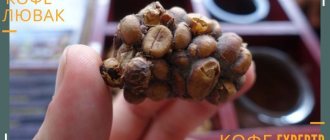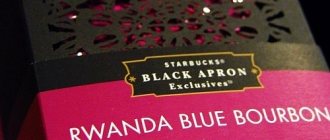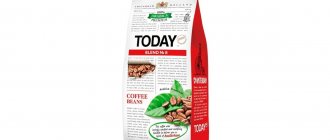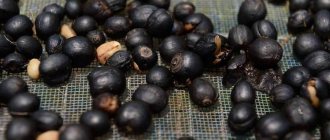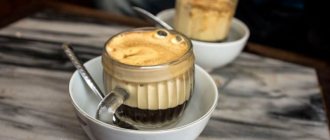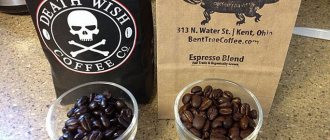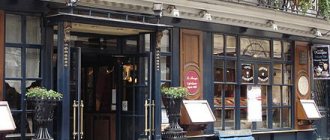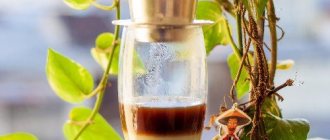Production Features
Coffee berries are usually collected by people manually or mechanically, after which the fruits are washed, dried under the sun, and cleared of pulp and shell. The whole process takes a lot of time, and musangs cope with processing on average in a day.
- Don't miss: Interesting and little-known facts about coffee
In the stomach of an animal that eats coffee beans, fermentation of the berries occurs. The workers just have to wash, dry and fry the resulting product. A civet can eat up to 500 g of fruit per day, and a much smaller amount retains its presentation.
In nature, animals select only the best berries, but in cages they are forced to eat what farmers give. Running after wild animals in search of excrement is a dubious pleasure, and the process itself is not very productive. For this reason, modern expensive Luwak coffee is produced by animals imprisoned in cages.
Musangs are not able to reproduce in captivity, which is why the composition of the farm is constantly updated. You can get no more than 270 kg of animal-fermented coffee per year. The low figures are explained by seasonality and the limited number of musangs involved in the production process.
Luwak coffee reviews
As most gourmets admit, the described drink causes mixed reactions. Not everything is pleasant and good, which is expensive. So, Luwak coffee reviews:
- a girl wrote on one of the forums that what always stopped her from purchasing Luwak coffee was the originality of production and the number of counterfeits (and in Russia this is generally a problem!). Apparently I bought a lot of materials and videos on this topic. My intuition didn’t let me down, I bought a quality product. Appreciated him;
- She is echoed by a guy who admits that the coffee is excellent, the taste attracted him with a slight sourness, which does not spoil the taste, but, on the contrary, complements it. It’s expensive to drink such a drink every day, but on weekends it’s just right;
- a group of friends tasted coffee, each of them was satisfied. What was especially striking was that the drink completely lacks the bitterness inherent in regular coffee. The aroma is subtle and pleasant. The only problem is the hefty cost of the product;
- another guy admitted that he was thinking about how he could spend so much money on coffee! Coffee! It turned out that the taste is more than unusual - soft, and seemingly weightless;
- Among the words of praise there are also critical ones. There are people who claim that Luwak coffee tastes simply disgusting. Firstly, lifeless, secondly, faded. So, not for everyone...
Taste characteristics of an expensive drink
Under the influence of the civet's gastric juice, the grains are deprived of some components. Acids and some of the protein compounds that give regular coffee its characteristic bitterness are neutralized. After high-quality washing and frying, there are no foreign odors or aftertaste.
True connoisseurs of the exotic drink note honey and caramel tones in the brewed portion, as well as light chocolate notes.
The taste is balanced by reducing acidity and bitterness due to the participation of another unique substance in the processing of berries - civet. Musk is produced by the glands of only these small animals, which is the originality of the production. Real coffee processed by animals can also have a pleasant creamy taste with subtle notes of vanilla.
Eco-friendly Kopi Luwak
Sustainably produced Luwak coffee is obtained in a modern and humane way. No animals are involved in the process.
The taste, aroma and properties of high-quality, sustainably produced Kopi Luwak fermented coffee are achieved thanks to:
- carefully selected high-quality coffee cherries;
- innovatively recreated fermentation process;
- masterly skill of the roaster.
Eco-friendly Kopi Luwak coffee is a harmony of well-chosen blends of coffee berries and combinations of different types of roasting.
Here we can talk about a kind of “luwak sommelier”. Eco-friendly luwak sometimes surpasses other types of this coffee in its taste and quality characteristics. Benefits of Kopi Luwak Eco-friendly Production
:
1. Guaranteed quality and the same taste from batch to batch;
2. Reasonable price - you can buy Luwak coffee at an affordable price and enjoy the true taste;
3. 100% safety guarantee - environmentally friendly production does NOT involve contact with animal excrement;
4. Prepared by experts who know the true taste of Luwak coffee, but value the life and freedom of animals.
Classic cooking method
Residents of Sumatra brew the drink according to a traditional recipe:
- 1 ½ tsp. Place ultra-fine ground Luwak coffee into a well-heated ceramic container.
- Add 160 ml of boiled water, cooled to a temperature of 90 °C.
- Mix the ingredients thoroughly, cover with a saucer and let sit for no longer than 5 minutes.
This is interesting: How coffee is brewed in Vietnam
Luwak coffee producers believe that the taste of the drink is maximized when ground with powder.
How to brew
To enjoy the taste, you need to know how to properly prepare the drink. In Vietnam, it is not customary to brew coffee in a Turkish coffee pot. To do this, use a cup, pour condensed milk into the bottom, add freshly ground coffee and press it with a press. Only after this is boiling water poured.
At home you can make Turkish coffee. Some coffee lovers advise adding a little sugar to the drink during the brewing process, which will help obtain a thick foam and rich aroma. And some claim that a few grains of salt added to the drink during cooking improves the taste.
To prepare Luwak coffee, you can use the following recipe:
- an empty Turk is warming up on the fire;
- freshly ground grains (3 tsp) and a little sugar (to taste) are poured into it;
- the mixture is heated and only after that cold water (250 ml) is added;
- the coffee is boiled over low heat until foam forms;
- the Turk is removed from the heat at the moment when the foam begins to rise;
- The prepared drink should be poured into cups.
If desired, add cognac, milk or cream to the coffee.
You can make coffee with spices using approximately the same recipe. Add cardamom (5 pcs.), cloves (1 spice) and ground ginger (0.5 tsp) into a heated pot and mix. Add 3 tsp. coffee, stir again. Pour 250 ml of cold water. Place the Turk on low heat. Wait for foam to form and remove from heat. Wait until the foam goes down and put the Turk back on low heat. The procedure is repeated 2 times.
Original and analogues of the product
It is almost impossible to find the real Kopi Luwak variety in the public market. By naturalness, experts mean the participation of free animals in the process. The human function is to travel through the jungle in search of animal excrement - the “wild” harvest is no more than 80 kg of grains per year.
Nowadays, some of the most expensive coffee in the world is made from dung on the farm, which reduces the value of the product. The closer the product is to the country of origin, the lower the risk of purchasing a counterfeit.
Modern entrepreneurs have taken the natural fermentation process as a basis and brought new varieties of the drink to the market. For example, Thais get their coffee from elephant dung, Black Ivory Coffee.
Kopi Chon is the name for coffee made from animal feces from Vietnam. The palm marten also lives there, but in the local dialect it sounds “chon”, not “luwak”. The production scheme is no different from Kopi Luwak, but the Thai variety received a good advertising campaign, and the Vietnamese brand is not yet very popular.
How the world's most expensive coffee is made from musang excrement
The scientific name of the Musang - Paradoxurus hermaphroditus - is not true: the Musang is not a hermaphrodite. The animal reproduces in the same way as most animals. The mistake crept into the name due to the fact that both females and males have glands resembling testicles. What the researchers were not mistaken about was the identification of paradoxurus.
The most valuable thing a musang has is not fur or meat, but... excrement. They are used to produce one of the most expensive types of coffee - Kopi Luwak.
The secret is that the musang loves to eat the berries of the coffee tree, and chooses the most fleshy and ripe fruits. The acids in the animal's gastrointestinal tract clean and ferment coffee beans, stripping them of their outer shell and, with it, bitterness. By collecting the waste products of the musang (which, by the way, do not have any unpleasant odor) and washing the processed beans, you get expensive coffee. The price of a kilogram can exceed $1,000, and a cup of the drink can cost $10.
For a long time, no one outside Asia would have known about the musang palm marten, if not for one “discovery.” Not so long ago, these animals became famous throughout the world due to the fact that it is with their help that the world's most expensive coffee variety, Kopi Luwak, appears. Anyone who hasn't heard this name is not a real coffee lover. “Kopi” means “coffee” in Indonesian, and “Luwak” is a small arboreal animal.
The Kopi Luwak brand appears in any article related to coffee as the best, most sophisticated and most expensive type of coffee in the world. There are whole legends about the chocolate-vanilla taste of the drink, which is made with the participation of palm civets (in Indonesian - “Luwak”) - animals of the civet family.
The gastric juice of musangs contains civet (musk), an odorous substance that gives coffee the flavor of honey and nougat. Therefore, Kopi Luwak is known for its characteristic balanced taste with a delicate bitterness, a distinct hint of butter, hints of nougat and honey, as well as a long, persistent pleasant aftertaste.
Currently, Kopi Luwak coffee in Indonesia is produced on special fur farms on an industrial scale. Musangs on such fur farms are kept in cages. They are fed the fruits of the coffee tree and their excrement is collected.
The musang or luwak is a small carnivore and lives in trees. Its weight varies from 2 to 5 kg, and its body length ranges from 48 to 59 cm, tail length - from 44 to 54 cm. The Musang's coat is most often colored gray, with black stripes on the back, which turn into individual spots. The paws, ears and muzzle are also painted black. Musang has an exceptional sense of smell. Under the cover of darkness, he sneaks into coffee plantations, where he selects the most fragrant and ripest coffee berries and eats them. The Luwak diet is quite varied, but coffee is not the last place in it. Luwakis are very picky eaters, they can even be called gourmets. If you put a kilogram of coffee beans, they will only choose about 12 of them.
February 7, 2011. Bangli district, Bali. A wild musang climbs a coffee tree growing on a plantation on the island of Bali, Indonesia.
Musangs, being nocturnal animals, actively feed and hunt in trees, easily climbing them like cats. They also move quickly on the ground. Their food is mainly fruits, insects, bats, birds and bird eggs, in addition: worms, various rodents, snakes, lizards. In trees they deftly hunt for squirrels and their young.
The name "kopi" is translated as the local name for musang, as well as coffee. These cute creatures, eating coffee fruits, process it and excrete it in almost pure form, but under the influence of enzymes, processes take place in their intestines that improve the quality of the beans.
August 11, 2009. Bondowoso, surrounding the city of Surabaya, East Java, Indonesia. The farmer sorts the coffee cherries and selects those considered unsuitable for production. Coffee produced by Indonesian civet cats is known for its delicate aroma, and the only enzymes in the civet stomach give the coffee a particularly smooth taste. The retail price per pound of this coffee ranges from $100 to $600.
August 11, 2009. Bondowoso, surrounding the city of Surabaya, East Java, Indonesia. The supply of Kopi Luwak coffee is very limited, with only about 1,000 pounds reaching the market each year. Heritage Tea Rooms, a small coffee shop near Townsville, Australia, serves this type of coffee for $50 AUD per cup (about $33 USD).
The life of the musang passes exclusively at night, since during the day it sleeps in trees, nestling in the forks and interweaving of branches and vines. Leads a solitary life, without forming flocks. It meets with individuals of its own species only during the mating season.
In modern conditions, musangs actively inhabit the space near people - attics, stables, and bring great benefits to people, destroying their worst enemies - rats and mice, and preventing the development of various epidemics.
The female gives birth to two to four babies after a two-month pregnancy. She takes care of them, protects them from enemies and feeds them with milk for up to a year. Easily tamed, musangs become the same friends of people as cats.
Initially, until someone figured out how to make huge money from civet cats, this little coffee lover was considered a pest, since the luwak eats much more beans than it can digest. But undigested coffee beans, once in the animal’s intestines, undergo an amazing processing process - the process of purification and fermentation. As a result, the acids in the civet's intestinal tract remove some of the bitter substances from the beans, which improves its quality and makes the taste sweeter, thereby changing the taste of coffee.
August 11, 2009. Bondowoso, surrounding the city of Surabaya, East Java, Indonesia. Coffee fruits are placed on trays to be eaten by civet cats. (Ulet Ifansasti/Getty Images)
The coffee beans then leave the Luwak body naturally and remain on the surface of the earth. It is these coffee beans that have passed through the intestines of an animal and were collected in the jungle that become the Kopi Luwak. This type of coffee has a balanced taste with a delicate bitterness, with a predominant hint of butter, nougat and honey, as well as a long, persistent pleasant aftertaste. Therefore, “Kopi Luwak” is rightly called the drink of the gods. Since its production volume is very small and does not exceed several hundred kilograms per year, this rare variety of coffee commands a high price.
Today, this type of coffee has been produced on an industrial scale on special fur farms. The animals are kept in cages there. In captivity, civets are deprived of the opportunity to choose the best coffee berries and are forced to eat what the staff feeds them. Therefore, the diet of civets on farms differs from their natural diet, which is also reflected in the taste of the drink.
August 11, 2009. Bondowoso, surrounding the city of Surabaya, East Java, Indonesia. Workers collect coffee beans ready for final washing and drying.
Civet excrement is prepared for the production of "Kopi Luwak" coffee in Bondowozo, East Java, near Surabaya, Indonesia.
However, if you type the phrase “the most expensive coffee made from poop” on the Internet, you may find another option (and it seems to me that no matter who removes it from the body, such coffee will be the most expensive  )
)
According to another version, the most expensive coffee in the world is produced in the area at the junction of Thailand, Laos and Myanmar. Connoisseurs highly value the so-called “elephant” coffee. Therefore, a kilogram of “Black Ivory”, coffee made from the waste of the largest land animal on the planet, costs more than a thousand dollars.
Black ivory, according to coffee lovers, has a unique taste that is given to it by enzymes in the intestines of elephants. First, the elephants are fed ordinary coffee beans, which are processed in the gastrointestinal tract of the giants. Once they come out of the elephants naturally, they have an unusual mild taste and aroma that cannot be achieved in other types of coffee.
You can taste Ivory coffee only in a few five-star hotels in northern Thailand, the Maldives and Abu Dhabi. There is nothing surprising in this, because a cup of this drink costs a little less than 50 dollars, and a kilogram - 1100.
The world's most expensive coffee is produced in the so-called Golden Triangle, a place at the junction of Thailand, Laos and Myanmar, previously known for drug production.
According to Canadian elephant coffee producer Blake Dinkin, when the coffee beans enter the elephant's stomach, the acid breaks down the protein that gives the coffee its bitterness. So the absence of the usual bitterness and mild taste are the distinctive features of Black Ivory.
Compared to another very expensive type of coffee, obtained as a result of digestive processes in the stomachs of civets, elephant coffee has an important advantage. In the huge stomachs of the largest land animals, the process of “preparing” coffee lasts for 30 hours. During this time, the grains are mixed with bananas and sugar cane, the favorite delicacies of elephants, and acquire unique taste qualities.
Blake Dinkin explains the high price of coffee beans processed in the stomachs of elephants by the fact that their labor productivity is too low. To get 1 kilogram of Ivory, elephants need to feed 35 kilograms of expensive Arabica coffee. Despite the high price, Dinkin sold about 70 kilograms of the first “harvest” in November. By 2013, he hopes to produce half a ton of elephant coffee.
[media=https://www.youtube.com/watch?v=vb0-i7gJW4E]
Current prices
The most expensive coffee today is Black Ivory - the cost reaches $1,200 per 1 kg of beans. The price of Luwak coffee in Vietnam is 180 USD. per kilogram, “wild” is an order of magnitude more expensive - the maximum level is set at 4000 USD. It is recommended to buy the product directly from farmers if you are planning a holiday in countries with established production.
You can contact official dealers, but there is a risk of purchasing a low-quality product. The price of Luwak coffee in Moscow for 1 kg varies between 25-30 thousand rubles, so the number of people wishing to distribute counterfeits is increasing every year.
The rise in popularity of one of the most expensive drinks occurred in the second half of the 20th century, when, due to problems in the coffee market, gourmets were happy with any type of coffee. Then the demand for Luwak decreased, the hype subsided and resumed after the release of the Hollywood film “Until I Played the Box.”
The secret of Kopi Luwak's popularity lies in the dexterity of marketers who picked up the idea of natural eco-products. Every year, thousands of kilograms of expensive coffee are supplied to the market - and these figures run counter to actual production data.
Other expensive coffees
In addition to those varieties of coffee that are obtained thanks to animals, there are no less valuable ones produced in a less exotic way. Expensive varieties of coffee grown in the traditional way are distinguished by their exquisite taste only due to the peculiarities of climatic conditions and the varieties of the coffee trees themselves. Below is a rating of especially valuable ones.
- Hacienda La Esmeralda ($100–125 per 1 kg), produced in Panama, Arabica plantations are located high in the mountains in the shade of spreading Guavas. The drink has a mild but rich taste and is considered the purest in the world.
- St. Helena Coffee ($80 for 500g), grown on St. Helena Island. Features citrus, floral and caramel notes in the finished drink.
- El Injerto from Guatemala ($50 for 500g). The finished drink has the taste and aroma of exotic berries, chocolate and fruits with a nutty aftertaste.
- Fazenda Santa Ines from Brazil ($50 for 500g). Winner of many world awards at coffee exhibitions. Has a taste of citrus and chocolate.
- Blue Mountain from Jamaica ($50 for 500g). It is grown in the mountains at an altitude of over 1500 meters. Gives a rich taste of chocolate and fruit with exquisite notes of red pepper.
Traditionally, expensive coffees are sold in beans. Instant is not included in the list of elite products. It’s also difficult to say which one will suit your taste. One thing is known: products marked as elite, as a rule, confirm their special position, so it’s worth allowing yourself to eat them at least occasionally.
French influence
From the mid-19th century and throughout the century, Vietnam was, in fact, a colony of France, which determined the gastronomic preferences of the country's inhabitants. The French presence is everywhere. It gave the Vietnamese a love for freshly baked baguettes, croissants and strong coffee.
And it was like that.
1857 The first Arabica typica and yellow bourbon trees were planted in Hanam province. For almost forty years, Arabica tried to take root in the cool mountains of Vietnam with varying degrees of success, but the trees suffered from diseases and died. And then, at the beginning of the 20th century, strong and disease-free robusta was brought to the plantations for the first time. Until the end of the colonial period, coffee was supplied exclusively to France, and during the Vietnam War, production was completely abandoned.
1976 North and South Vietnam united and the country's coffee boom began. 10 years later, Vietnam became 31st in the list of producing countries, and in 2000 it took 2nd place in the world, second only to Brazil. The country supplies the world with more than a million tons of coffee per year. And almost all of it is robusta.
“Robusta makes up 90% of the coffee produced in Vietnam. There are half a million small private farms here and may employ several million people during harvest.”
However, Arabica is also available. Basically, the plantations grow varieties such as catimor, bourbon and the very common Vietnamese Dalat. The latter has a balanced taste with berry sourness, nutty and bread notes.
The most popular varieties of Robusta: strong, thick “Sang Tao” with a bittersweet taste, and “Blue Dragon”, in which bitterness is almost not manifested, but notes of cocoa, fried bread and pistachios are expressed.
Geographical features of growth
Basaltic soils and the corresponding climate created excellent conditions for growing coffee in this region. It was the noticeable difference between day and night temperatures that provided the conditions for the full development of grain, as well as the formation of the necessary acids in it.
Harvesting takes place from October to mid-January. This allows harvesting from each tree up to four times. To create comfortable conditions for growing Arabica, special trees are planted that create shade, mainly persimmons. This method allows farmers not only to protect coffee trees from direct sunlight, but also to earn additional income.
